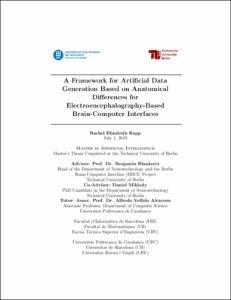A framework for artificial data generation based on anatomical differences for electroencephalography-based brain-computer interfaces

Visualitza/Obre
Estadístiques de LA Referencia / Recolecta
Inclou dades d'ús des de 2022
Cita com:
hdl:2117/167803
Realitzat a/ambTechnische Universität Berlin
Tipus de documentProjecte Final de Màster Oficial
Data2019-07-01
Condicions d'accésAccés obert
Tots els drets reservats. Aquesta obra està protegida pels drets de propietat intel·lectual i
industrial corresponents. Sense perjudici de les exempcions legals existents, queda prohibida la seva
reproducció, distribució, comunicació pública o transformació sense l'autorització del titular dels drets
Abstract
One of the major limitations of brain-computer interfaces (BCI) is the need for
a long and tedious calibration period in order for a subject to become proficient
with the system. A principal challenge in training a BCI classifier that should
work without user-specific calibration is that the training set is not large enough
to capture the spectrum of potential signals. In this thesis, a new method to
reduce BCI calibration time is proposed. Since one cause for subject-to-subject
variability is the anatomical differences between subjects, we aimed to generate
artificial data which would resemble the signals obtained from a new subject
with a different cortical anatomy. This would allow for a large expansion of
the training set size. To generate the artificial data we begin by decomposing
the original signals, localizing the most prominent sources and shifting their
orientation relative to the cortex. New signals are then regenerated using different
head models. Training a classifier on the enriched training set should
result in better generalizability. Although inter-subject classification ultimately
fell outside the scope of this thesis, we consider intra-subject classification as
a starting point for consideration of the methods applied. This ultimately lays
the foundation for a much greater field of research involving the use of artificial
data generation to combat the calibration time issue for BCIs.
MatèriesBrain-computer interfaces, Neural networks (Computer science), Interfícies cervell-ordinador, Xarxes neuronals (Informàtica)
TitulacióMÀSTER UNIVERSITARI EN INTEL·LIGÈNCIA ARTIFICIAL (Pla 2017)
Col·leccions
| Fitxers | Descripció | Mida | Format | Visualitza |
|---|---|---|---|---|
| 143659.pdf | 10,49Mb | Visualitza/Obre |

